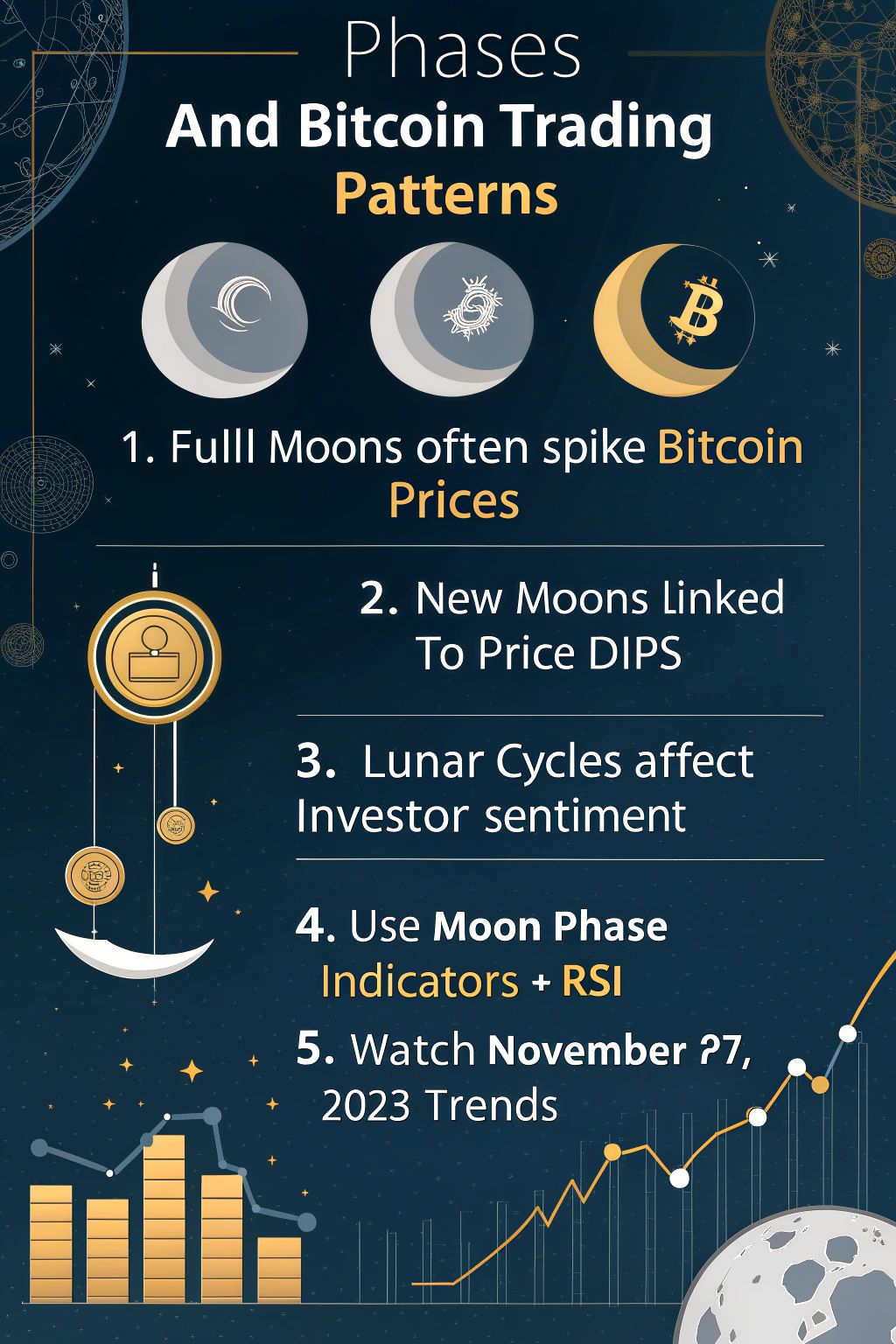Do your Bitcoin trades feel like wild guesses? Some traders think the moon phases, like full moons and new moons, may affect market sentiment and price volatility. This blog explains how lunar cycles might align with trading strategies to help you spot trends.
Curious if tides in space can sway crypto? Keep reading.
Key Takeaways
- Moon phases, like full moons and new moons, may affect Bitcoin trading patterns. Historical studies link lunar cycles to price movements and investor sentiment shifts.
- Full moons often show increased market activity with potential spikes in Bitcoin’s price. For example, traders saw annual returns of 4.4% using the S&P 500’s “Full Moon Strategy.”
- New moons are linked to calmer markets or dips in prices. Selling during this phase has shown lower maximum drawdowns (e.g., 44%) compared to other periods.
- Tools like the Moon Phase Indicator combine lunar data with technical analysis tools such as RSI or moving averages for better trading predictions.
- Future key dates include a full moon on November 27, 2023, which historically led to sharp changes in Bitcoin trends due to emotional shifts among investors.

Understanding Moon Phases and Their Influence on Markets

The moon’s phases affect more than the tides. Some traders think they can sway market trends, including Bitcoin’s ups and downs.
Basics of Lunar Cycles
A lunar cycle lasts about 29.5 days. It starts with a new moon and ends at the next new moon. Midway through, a bright full moon appears. Each phase includes waxing crescents, first quarters, waning gibbous shapes, and more.
Lunar quarters divide the cycle into smaller parts of 7.38 days each. Over one lunar year (354.37 days), these patterns repeat themselves many times due to the gravitational pull between Earth and its companion in space—our moon.
“The phases of the moon are like clockwork for nature—and maybe markets too.”
Patterns like these influence tides on Earth and could also sway investor sentiment in financial markets such as Bitcoin trading!
Historical Market Responses to Moon Phases
Shifting focus from the basics of lunar cycles, let’s examine how moon phases have historically influenced financial markets. Several studies offer fascinating insights into the patterns tied to the moon.
| Aspect | Details |
|---|---|
| Stock Market Trends | New moons were linked to higher stock returns. A “Journal of Empirical Finance” study highlighted this, suggesting investor sentiment shifts during this phase. |
| Outperformance Over Years | A 20-year study from the University of Lausanne revealed lunar-based trading strategies outperformed the average market by 3.3% annually. |
| Crypto Market Insights | Bitcoin trading patterns also displayed similar correlations. Prices often fluctuated more during full moons, hinting at increased market activity. |
| Short-Term Spikes | Lunar cycles led to noticeable short-term price movements, particularly during new moon phases, as per multiple statistical analyses. |
| Investor Sentiment | Researchers from the University of Zurich observed improved returns tied to lunar phases. Over five years, investors gained 6.8% more on moon-based strategies. |
| Emotional Trading Patterns | Psychological factors, such as optimism, often peak during new moons and dip during full moons, influencing market trends. |
These studies suggest a real yet complex link between lunar cycles and market behavior. Investors and traders have long experimented with these ideas to seek an edge.
The Moon Phase Indicator in Bitcoin Trading
The Moon Phase Indicator tracks lunar cycles to spot trends in Bitcoin trading. It helps traders find patterns in price shifts during different moon phases.
Definition and Functionality
The Moon Phase Indicator uses lunar cycles to guide Bitcoin trading. It connects moon phases, like the full moon or new moon, with price movements in cryptocurrency markets. Traders notice spikes in activity during these times, often linked to market psychology and technical analysis tools.
This indicator works by combining Bollinger Bands, RSI-EMA, and moving averages with lunar data. Taihuttu’s Didi BAM BAM tool tracks phases such as waxing gibbous or waning crescent alongside momentum indicators like MACD and stochastic oscillators.
These signals help traders predict booms and busts tied to Bitcoin’s monthly options cycles.
Full moons have sparked increased crypto trades, says Taihuttu about using lunar patterns in financial markets.
How to Calculate and Interpret Moon Phase Percentages
Understanding moon phase percentages can guide Bitcoin trading. These steps break it down simply and effectively:
- Look up the lunar cycle calendar for the current month. Identify dates for full moons, new moons, and quarter phases.
- Divide a single lunar month (29.53 days) into four key phases: new moon, first quarter, full moon, and last quarter. Each phase lasts about 7.38 days.
- Assign each day of the lunar cycle a percentage value. Day 1 starts at 0% (new moon), day 15 reaches 100% (full moon), and day 29 returns to 0%.
- Use these percentages to track Bitcoin price behavior during specific moon phases. Historical data often shows shifts in market trends tied to those dates.
- Install apps or use online tools like Moon Phase Pro to automate calculations quickly.
- Compare the calculated percentages with market data trends on Bitcoin trading volume and price movements over time.
- Check past statistical analysis that links full moons with higher risks but potentially greater annual returns like the reported 3.5%.
- Interpret results by focusing on risk-adjusted return rates during high-percentage/full-moon days and lower percentages/new-moon days.
- Use tools such as Relative Strength Index or simple moving averages for extra confirmation when reading these patterns alongside moon phase changes.
- Integrate data insights into trading strategies by timing decisions near significant lunar points for better results in cryptocurrency markets.
Historical Data on Moon Phases and Bitcoin Performance
Bitcoin’s price seems to dance with the moon’s orbit in curious ways. Trends show price movements often align with full moons and new moons, offering hints for day traders.
Overview of Past Trends
Moon phases have long sparked interest in financial markets like stocks and cryptocurrency trading. Historical data shows some traders use the lunar cycle to predict price movements.
For example, certain studies noticed increased volatility during full moons compared to new moons across various stock exchanges.
Bitcoin’s price patterns also reveal interesting behaviors tied to moon phases. During bear market periods, short positions often saw higher returns near specific lunar times, such as a full moon.
In 2021, Bitcoin’s value peaked near $70,000 but dropped sharply afterward. These shifts intrigue technical analysts who examine correlations using tools like statistical deviation and market trends analysis.
Statistical Analysis of Moon Phases and Bitcoin Returns
Some traders swear by data. The numbers often tell a story, and the relationship between moon phases and Bitcoin trading is no different. Here’s the statistical breakdown:
| Strategy | Annual Return (%) | Time Invested in Market (%) | Risk-Adjusted Return (%) | Maximum Drawdown (%) |
|---|---|---|---|---|
| Standard Moon Phase Strategy (Bitcoin) | 32.2 | 50 | 65.6 | 81 |
| Improved Strategy with Seasonal Condition (Bitcoin) | 43.3 | 34 | 126 | 56 |
| Full Moon Strategy (S&P 500) | 4.4 | 50 | 8.8 | 49 |
| New Moon Strategy (S&P 500) | 2.8 | 50 | 5.6 | 44 |
The numbers highlight a sharp contrast. Bitcoin’s annual returns consistently outperform those of the S&P 500 under lunar-based strategies. A drawdown of 81% may seem staggering, but the risk-adjusted return of 65.6% still makes it appealing.
Adding seasonal adjustments improves results. This significantly cuts the maximum drawdown (56%) while boosting annual returns (43.3%) and risk-adjusted returns (126%).
By comparison, moon phase trading on the S&P 500 yields modest results. Full moon strategies deliver a 4.4% annual return, whereas new moon strategies hit just 2.8%.
The seasonal approach clearly shines brighter for Bitcoin. Next, let’s explore how you can shape your trading strategies using lunar cycles.
Practical Trading Strategies Using Lunar Cycles
Trading with the moon cycles isn’t just for stargazers. Learn how to use these natural patterns to make sharper Bitcoin moves.
Timing Investment Decisions with the Lunar Cycle
Timing your trades with moon phases sounds odd, but some data links lunar cycles to market patterns. Traders use moon phases as signals for entry and exit points.
- Track Full Moons for Buy Opportunities
Studies suggest going long on full moon days may increase returns. For example, the S&P 500 recorded a 4.4% annual return using this approach. Risk-adjusted returns hit 8.8%. Market sentiment often shifts positively during this time, making it ideal for buying Bitcoin.
- Sell During New Moons
Historical data shows selling at the open on new moons can limit losses. The S&P 500 strategy saw a 2.8% annual return here, with a lower maximum drawdown of 44%. Bitcoin trends follow similar patterns, where bearish moves are more common after new moons.
- Use Lunar Percentages in Technical Analysis
Calculate the “moon phase percentage” between new and full moons to refine decisions. A higher percentage indicates proximity to a full moon, signaling bullish sentiment. Lower percentages closer to a new moon suggest possible price dips.
- Pair Moon Phases with Market Volume
Align lunar cycles with rising or falling trading volume in cryptocurrencies like Bitcoin or Ethereum. Higher volume near full moons often leads to sharper price movements upward. During lower-volume periods near new moons, volatility tends to ease off.
- Leverage New Moons for Risk Management
Use the predictive dip after new moons to adjust stop-loss levels or secure gains early in case of sharp declines. Minimize investment risk by limiting exposure around these dates when markets show instability.
- Consider External Astronomical Events Too
Other events like Mercury retrogrades sometimes overlap with lunar phases, spiking market volatility further. Combine these insights with past Bitcoin trends during such periods to make informed timing decisions.
Leveraging New and Full Moons for Entry and Exit Points
Using the lunar cycle can guide your Bitcoin trading. Full moons and new moons often affect market trends, providing key moments to act.
- Go long during full moons
Historical data shows full moon days can bring positive returns. Opening a long position on these days may result in gains. For instance, traders using the S&P 500’s full moon strategy saw an annual return of 4.4%. Risk-adjusted returns reached 8.8%, making it a promising approach.
- Sell at the open on new moons
New moons tend to align with market cooling periods. Selling at the opening during these phases could help avoid dips. The S&P 500’s new moon strategy shows an annual return of 2.8%. This lower risk setup also had a smaller maximum drawdown at 44%.
- Track price movements near lunar events
Cryptocurrency markets like Bitcoin often mirror trends seen in stocks around lunar cycles. Sudden price changes can match these celestial shifts, signaling ideal entry or exit times.
- Use technical analysis alongside moon phases
Combine tools like moving averages with moon phase strategies for better results. For example, if a new moon coincides with low trading volume, it might signal reduced momentum in Bitcoin prices.
- Mind the timing window around each phase
Full and new moon effects don’t last forever but may influence markets for 1-2 days before or after these events.
- Follow seasonality tied to lunar cycles
Lunar impacts often blend with other seasonal market trends or astronomical events like solar activity or sunspot cycles, which can amplify reactions.
Influence of Astronomical Events Beyond Moon Phases on Markets
Astrological events, like Mercury Retrograde, can shake up crypto prices. These cosmic shifts often spark fear or excitement in traders.
Understanding the Impact of Mercury Retrograde Periods on Crypto Market Volatility
Mercury retrograde periods may trigger market instability. Many traders react to these events, leading to unpredictable price movements in cryptocurrencies like Bitcoin. Some speculate that beliefs surrounding Mercury retrograde affect decision-making and market sentiment during this time.
Increased trading activity has been noted, which amplifies volatility for both day traders and long-term decision-makers. Full moons or other lunar phases overlapping with retrogrades can further impact trading volume.
Certain trading algorithms, such as the Didi BAM BAM system, use lunar cycles alongside other factors for predictions in financial markets. Academic studies offer mixed results on how celestial phenomena influence cryptocurrency performance, though some suggest lunar cycle-based strategies can outperform standard approaches.
Shifts in trader behavior during Mercury retrograde highlight the psychological effects of such astronomical events on crypto markets. Next is an analysis of future projections based on these patterns within cryptocurrency trends over time.
Future Projections: Lunar Cycles and Cryptocurrency Markets
Upcoming moon phases might shape how traders plan their moves in the crypto market, giving you a fresh angle on what lies ahead.
Expected Trends Based on Past Data
Bitcoin showed growth after the bear market signs ended in November 2022. By January 2023, Taihuttu’s model confirmed this upward trend. Bitcoin exceeded $19,000 during this phase, prompting re-entry from investors like the Taihuttus.
Patterns suggest price movements around full moon and new moon cycles could align with higher trading volume. Past analyses hint that lunar cycles may influence market sentiment and cryptocurrency stability.
These trends lay ground for potential trading strategies using upcoming astronomical events..
Upcoming Full and New Moons and Potential Market Impact
Full and new moons often stir curiosity in traders. Their timing can impact market sentiment and price movements. Understanding how can help refine trading strategies.
- Next Full Moon’s Date
The next full moon is on November 27, 2023. Historically, full moons are linked to heightened trading volume. Taihuttu observed that emotional shifts often align with these phases.
- New Moon Trading Opportunities
The upcoming new moon falls on December 12, 2023. Traders associate this period with calmer market sentiment. Volatility tends to drop slightly before finding new direction.
- Impact on Bitcoin’s Value Trends
During recent lunar cycles, Bitcoin’s price showed notable fluctuations around these dates. For example, the last full moon saw a rise of nearly 4% in a day.
- Timing Market Entries
Many traders plan entries or exits near moon phases. Full moons may signal short-term gains due to higher activity levels.
- Link to Market Psychology
Celestial cycles like moon phases influence emotions and buying patterns. New beginnings tied to a new moon often drive optimism among investors.
- Tracking Lunar Indicators
Technical analysis tools now incorporate lunar cycles for crypto predictions. Some use them alongside AI-driven insights for risk management.
- Monthly Options Expirations Connection
Bitcoin options typically expire end-of-month, close to full or new moons. These dates overlap and could amplify price action further.
- Focused Risk Management Tips
Sudden spikes during such periods demand extra caution from day traders. Setting stop-loss orders can protect returns during unpredictable activity swings.
- Next Astronomical Event Forecasts
While Mercury retrograde impacts broader markets, its effects combine strongly during certain lunar phases too—boosting instability briefly in cryptocurrencies like Bitcoin tokens.
Each phase offers opportunities for savvy cryptocurrency trading strategies aligned with expected trends and data-backed forecasts!
Actionable Trading Tips
Use moon phases to sharpen your trading game—plan moves around new and full moons for better timing.
Simple Steps to Incorporate Moon Phases into Trading
Moon phases can guide your cryptocurrency trading. Follow these steps to use lunar cycles in your strategy.
- Track the moon calendar. Note all full moons and new moons for the year. Apps like “Moon Phase Calendar” or websites provide accurate data.
- Enter trades on full moon days. Research shows Bitcoin often performs well on these dates. Open long positions at market open during a full moon.
- Sell Bitcoin at new moons’ open. Historical trends suggest prices tend to dip shortly after new moons. Exit trades or close positions early during this phase.
- Stay in cash between phases. Avoid active trading during waxing or waning gibbous and crescent periods. These days show less significant price patterns for Bitcoin.
- Evaluate past performance with data charts. Compare historical Bitcoin charts and moon phases for better insights into price movements and returns.
- Use technical analysis with lunar cycles. Combine tools such as RSI or Bollinger Bands with moon phases for a clearer view of market sentiment.
- Set alerts for key dates using apps or calendars synced to trading platforms like Binance or Coinbase Pro.
- Manage risks wisely on full and new moons by setting stop-loss limits around 5-10% of your entry price to avoid unexpected losses from market volatility.
Key Considerations for Risk Management
Risk management is crucial in cryptocurrency trading. Without it, you could face heavy losses. Here are key points to keep your trades safer:
- Set Stop-Loss Orders
Define a clear point where you’ll exit if the market turns against you. For moon phase strategies, this keeps drawdowns in check. For example, the Full Moon Strategy has seen a max drop of 49%.
- Limit Your Investment
Only use money you can afford to lose. Avoid putting all savings into one trade based on lunar cycles.
- Diversify Your Portfolio
Never rely solely on moon-based strategies or Bitcoin alone. Invest in other cryptocurrencies or financial markets to reduce risks.
- Backtest the Strategy
Test historical data before using real funds. For lunar cycles, study past performance and returns during new and full moons.
- Monitor Seasonal Trends
Trading tied to moon phases performs better with favorable market conditions but risks overfitting data.
- Keep Emotions Out
Market sentiment often shifts during volatile periods like Mercury Retrograde. Stick to your plan despite fear or greed.
- Review Results Regularly
Analyze your trades monthly or after major astronomical events. Track what worked and adjust for future moves.
- Use Leverage Carefully
High leverage increases potential gains but can amplify losses just as fast on bad entries.
This foundation ties directly into practical strategies using lunar cycles in trading decisions!
Conclusion
Moon phases and Bitcoin trading mix mystery with data. Some traders swear by full moons for market shifts, while skeptics call it chance. Patterns from lunar cycles may signal trends, but they aren’t a crystal ball.
Use them as part of your strategy, not the whole plan. In trading, balance instincts with facts—like watching tides but keeping an umbrella handy!
FAQs
1. How do moon phases affect Bitcoin trading patterns?
Some traders believe lunar cycles, like full moons and new moons, influence market sentiment and price movements in cryptocurrency trading. The idea is rooted in observing potential links between human behavior and financial markets.
2. Can technical analysis include moon phases for Bitcoin?
Yes, some unconventional trading strategies incorporate moon phases alongside traditional tools like statistics or day trading indicators to identify market trends and predict price movements.
3. Is there a connection between lunar cycles and trading volume?
Certain studies suggest that during specific moon phases, such as the full moon or new moon, shifts in emotions might impact risk management decisions and even alter Bitcoin’s trading volume.
4. Should I rely on lunar cycles alone for cryptocurrency trades?
No! While interesting, using only lunar cycles without other data—like technical analysis or artificial intelligence insights—can lead to poor risk management. Always balance your approach with solid information.
5. Do investors see better returns based on the moon’s cycle?
It’s debatable! Some claim improved return on investment by factoring in lunar patterns along with other strategies, but financial markets are unpredictable. Don’t bet the farm solely on the phase of the moon!




